By Barb Elliot
Yes, you read that right. It’s been a record-setting fall and winter for hummingbirds in Pennsylvania. According to hummingbird bander and expert Scott Weidensaul, as of February 22nd, 92 hummingbirds have been reported in PA since last fall. Five or six are still present, including a few in southeastern PA. These visitors are not the Ruby-throated Hummingbirds that visit our feeders and breed here during summer. They were gone by early October. These are vagrants, species that breed in the Pacific northwest, northern Rocky Mountains, or Alaska, and normally migrate to Mexico in fall. Some of them fly east for reasons not yet understood. Though this is not a new phenomenon, the number of reports for this fall and winter has been extraordinary. Are these numbers the beginning of a trend or just an aberration? Weidensaul and other ornithologists don’t know.
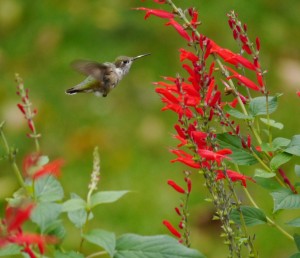
Calliope Hummingbird, Nov. 2, 2012, Devon, Chester County, PA. Photo © Barb Elliot. Click to enlarge.
Whatever the reason, it’s been an exciting time for birders and hummingbird enthusiasts! I was
privileged to see two of these birds. One was a tiny, pot-bellied Calliope Hummingbird that spent several weeks during October and November in a yard in Devon, Chester County — just
the second one ever recorded in PA. At about two-thirds the size of the familiar eastern Ruby-throated Hummingbird, the Calliope is the smallest bird species in the U.S. and the
smallest long-distance avian migrant in the world.
Another that I got to see was a beautiful immature male Allen’s Hummingbird that visited a feeder at a home in Pipersville, Bucks County from November through early January. This bird was only the third Allen’s ever recorded in the state.
Other western species to visit PA have been Rufous Hummingbird, the most common and numerous western visitors to the east, and a single Black-chinned Hummingbird — the very first record of this species in PA. This bird was seen briefly on just one day, but the Bucks County homeowner’s clear photos allowed experts to verify the record. Most western hummingbirds that fly east in the fall head south to the Gulf region by early January. As of this writing, however, two Rufous Hummingbirds linger in
Montgomery County and one in Chester County. All three birds first appeared at residents’ feeders in October and have stayed through the winter.
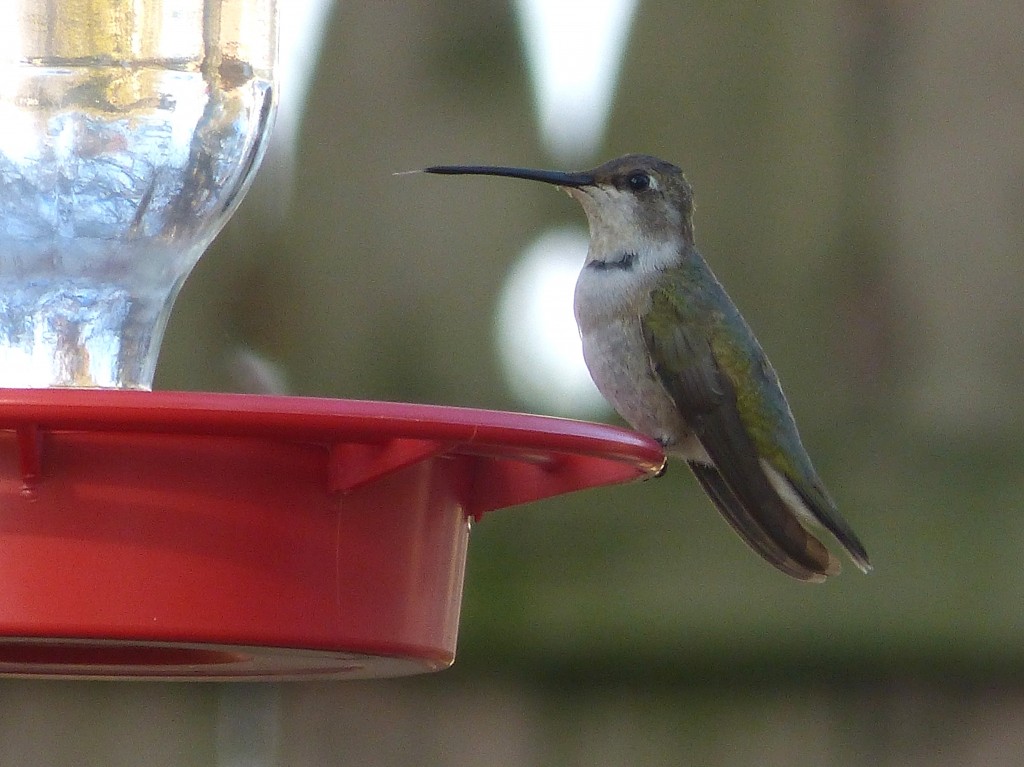
Black-chinned Hummingbird – first record in PA! Nov 11, 2012. Morrisville, Bucks County, PA. Photo courtesy of and © Rich Dulay. Click to enlarge.
How do these birds endure PA’s cold winter temperatures? At night, they enter a
deep sleep-like state called torpor, in which they lower their body temperature and slow their metabolic rate by as much as 50%. This allows them to conserve energy and
survive with enough remaining to fuel their first few feeding trips of the morning.
It’s too late to attract a western hummer this winter, but perhaps you’d like to try next fall. According to Weidensaul, in addition to keeping hummingbird feeders up well into autumn, many successful hummingbird hosts have late-blooming fall plants. There are several native plants that bloom until frost, but some homeowners also use non-native Salvia species, planted either in pots or in the ground. I recommend that you confine non-natives to containers and reserve in-ground space for natives. After all, natives contribute more fully to our local web-of-life. Also, if your non-natives are in pots, you can move them inside or into your garage if overnight freezing temperatures are forecast. The table below has some recommended late fall blooming natives as well as some non-natives that host western hummingbirds.
Though hummingbirds feed from any color flower, they are attracted to the colorred. To catch the eye of a passing hummingbird, some homeowners put out red ribbon, surveyors tape, or other red objects.
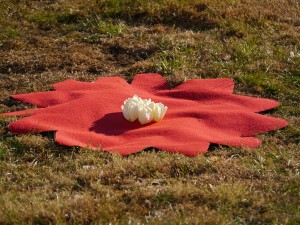
- Large felt flower in Pipersville, PA yard that attracted Allen’s Hummingbird. Nov, 2012. Photo © Barb Elliot. Click to enlarge.
The homeowner who attracted the Allen’s Hummingbird in Bucks County had made a two- to three-foot red “flower” of felt material and placed it on the ground near her feeder. I thought this was a great idea and made one for my yard.
If you are lucky enough to host a western hummingbird, it’s important to keep your feeder’s sugar water from freezing so the bird can eat first thing in the morning. Some homeowners erect a heat lamp near the feeder or wrap electrical wire around it. Others use two feeders, leaving one up overnight and just before dawn trading it for one kept in the house overnight.
If you host one of these rarities you can contribute to scientific knowledge. You should
have your hummingbird banded. The bander will record the bird’s location and
determine its species and age. If the bird is re-captured or found in another location, it yields very valuable information about its migratory patterns. Hummingbird banders are certified experts who trap, examine, and band these tiny creatures without harming them. Any hummingbird seen in PA after October 15th is likely a western rarity. Report it to the local Audubon Society or bird club so they can contact a bander. If possible, take some good photos of the bird as these can help with identification.
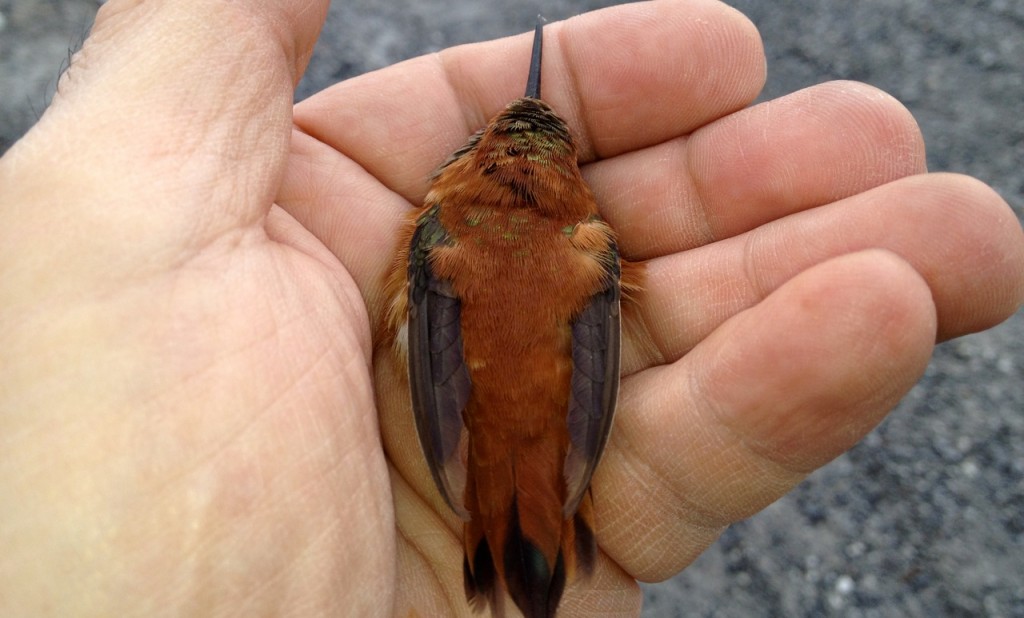
Male Rufous Hummingbird just after banding. Nov 28, 2012. Chester Springs, Chester County, PA. Photo courtesy of and © Nick Pulcinella. Click to enlarge.
Leaving feeders up into fall won’t prevent hummingbirds from migrating. They know when to move on. Your fall feeder may help the survival of late-migrating Ruby-throats or western hummers venturing east from the usual migration routes.
Ruby-throated Hummingbirds will begin returning to our area in late April and early May. I will be putting my feeders out by mid-April so I don’t miss any that might be flying over my neighborhood. Since hummingbirds are known to return to the same yards, I’m hoping for some of my “regulars”. I’ll also hang some red ribbon near the feeders and place my new felt “flower” out on the ground. I’ll watch my first-of-the-season native hummingbird plant, Wild Columbine. Other native plants in my yard will host the tiny insects that hummingbirds eat and feed their young. Then, come fall, I’ll be sure to keep my feeders out in the hope that a passing rare western visitor will come to grace my yard for a brief, but wondrous time.
———————————————————————————————————-
|
Native Fall Hummingbird Plants |
|||
| Botanical Name | Common Name | Bloom Color & Period | Conditions, Comments |
| Chelone glabra | White Turtlehead | Spikes of white flowers; late summer and fall | Part shade to shade, moist soil; may bloom even after first frost |
| Impatiens capensis | Jewelweed | Gold/orange flowers; July to October | Part shade to shade, moist soil; an annual that re-seeds |
| Lonicera sempervirens | Trumpet Honeysuckle | Red/orange flowers; Late spring to fall | Sun, dry to average soil; well-behaved vine; needs a trellis or other support; may bloom after first frost |
|
Non-Native Fall Hummingbird Plants (plant in containers) |
|||
| Salvia coccinea | Texas Sage | Red; other colors, e.g., salmon, pink, white; summer to frost | Readily available; easy to grow; native to U.S. coastal states from South Carolina to Texas |
| Salvia elegans | Pineapple Sage | Red flowers; September to heavy frost | Sun; well-drained soil; native to Mexico & Guatemala; many think this is the best Salvia for late hummers |
| Salvia guaranitica | Black and Blue Sage | Cobalt blue flowers in black calyx; summer to fall | Full sun to light shade; native to Brazil, Paraguay & Argentina |
| Salvia involucrata | Roseleaf Sage | Red flowers; late summer to early fall | Native to Mexico |
| Salvia splendens | Tropical Salvia/ Scarlet Sage | Red flowers; summer to frost | Full sun to part shade, average, evenly moist soil; native to Brazil |

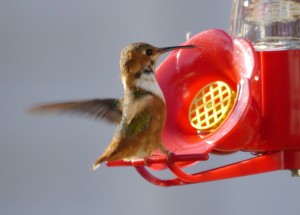
Friends in Cape May and Cumberland Counties believe that the Pineapple Sage is their best bet for western strays.
My friends Debbie and Randy Lyons in West Chester just forwarded the link to your blog to me. I was so excited to read this about stray western hummingbirds overwintering in southeast Pennsylvania! Love the photos!
I live in north central rural Maryland, just ten miles south of Gettysburg PA. Have never seen any stray hummers here, but now will be on the lookout. I have a great collection of Rubythroats all summer.
Thanks for your blog!
Best wishes from Anne
Thanks very much, Anne. Since I posted the article about western hummingbirds wintering in our area, another Rufous Hummingbird was reported in southeastern Pennsylvania. This was a female Rufous Hummingbird that has been present in Harleysville, Montgomery County, PA since October. Scott Wiedensaul banded the bird on March 1st and said that this is the 49th non-Rubythroat to be banded in PA during this fall/winter season. According to Wiedensaul, the bird is in excellent health, so it has come through the winter quite well.
Good luck with your hummers in Maryland, Anne!
Barb Elliot
I have a feeder in my backyard for less than a week and have had many types of hummingbirds at the feeder. I have identified a Ruby Throated but not the others. If the birds are still here in the fall, I would be interested in participating in the banding program. I live in Auburn,PA.
Nancy, thanks very much for your comment and for your interest in hummingbirds! It’s great that you have put up a feeder and have attracted them so quickly. The hummingbirds that you are seeing at your feeder now are most likely all Ruby-throated Hummingbirds, the only species that breeds in eastern North America during the spring and summer. These birds generally migrate from their wintering grounds in the tropics through and to Pennsylvania in late April or May. Beginning in mid- to late July, there is usually a lot more activity at feeders. Males (who do not help with rearing young) begin their migration south and stop at feeders along their route. Females and their now fledged young are spending a lot of time at feeders as they fatten up in preparation for their long migration to the tropics. Females and immature birds will begin migrating in late August and September. For more info, see: http://www.allaboutbirds.org/guide/ruby-throated_hummingbird/id
If you get a hummingbird at your feeder after October 15st, it is likely to be one of the species that breeds in western North America. These rare vagrants fly east instead of to their normal wintering grounds in Mexico. Please report such a bird to your local bird club or Audubon Society chapter so someone can contact one of Pennsylvania’s hummingbird banders, who can contact you about the possibility of banding the bird. Here’s a link to the local PA Audubon Society chapters around the state so you can get contact info of one near you: http://www.audubon.org/chapters?state=PA
Again, thanks for your interest in hummingbirds! Good luck!
Barb Elliot, Co-Director, Backyards for Nature
It is November 2nd 2013 here in Reading Pa and we have hummingbirds coming to our feeder. This is the first year we kept it out this late in the season so we are elated to see the visitors. We haven’t been able to catch them on film but we suspect at least one is a female rufous. We are keeping the binoculars and camera at the ready.
Hello Joanne and Jim. It’s so exciting that you are seeing a hummingbird at your feeder at this late date! Since we are now into November, it’s very likely that your bird is a vagrant from the west and not a Ruby-throated Hummingbird. Several Rufous Hummingbirds have been reported and banded in PA in the last week or two – in Northampton, Lancaster, and Allegheny counties, so the pattern that was seen last winter may be occurring again this year.
It would be great if you would have a hummingbird bander come to your home to band the bird. If you are willing to do this, please contact Scott Weidensaul about your hummingbird/s at scottweidensaul@verizon.net or 570 739-2874. Scott is an expert naturalist, birder, and hummingbird bander and will be able to positively identify and band your hummingbird. Time is of the essence with these visiting western hummingbirds, so please contact him as soon as possible. Sometimes these hummers don’t stick around for long.
Good luck!
Barb Elliot
Happy to report Scott Weidensaul was able to band a female Rufus hummingbird at a feeder on our back porch Sunday. Nov 3 2013. We hope she sticks around for a while. Mike Shull has taken some wonder photos of her. She has brought many new friends to our house to see her.
Joanne and Jim, thanks so much for sharing your experience with this beautiful adult female Rufous Hummingbird. Thanks, too, for contacting Scott Weidensaul to have her banded and for graciously opening up your property to allow birders to see her. Mike Shull generously provided his photos of her to me. I will try to post them at a later time, as I can’t seem to include any in this comment section. I hope your Rufous visitor will stay around for awhile longer so you can continue to enjoy her!
Barb
My cousin lives in somerset, pa & just had a rufous humming bird banded by a fellow from the Pitts aviary on oct 31, 2013 !
That must be so exciting for your cousin! Rufous Hummingbirds have been reported visiting feeders in several counties in PA in the past week or two, and the hummingbird banders are getting busy again. The end of October/first week of November is when reports of western vagrant hummers began last year, so we may be in for another fall/winter with a lot of these rare visitors. It’s good to keep feeders up at least through Thanksgiving just in case one of these rare visitors is in the area. Any hummingbird seen in PA from now on is likely to be a western species.
Thanks for sharing your cousin’s news!
Barb Elliot
Hi, I live in mechanicsburg pa and I am trying to attract hummingbirds. I have 2 feeders and a red flower hanging next to them. I also have regular bird feeders next to them. I was wondering if the regular bird feeders and the birds they attract will scare the hummingbirds away.
Hi. Sorry it has taken me so long to respond to your question. Hopefully by now you have seen a hummingbird at your feeder since they have begun returning to Pennsylvania over the past week or tow. If you haven’t seen any yet, be patient. It may take awhile for a hummingbird to discover your yard and your feeders.
Regarding your question, it might be a good idea to keep your hummingbird feeder/s 8 feet or more away from your other feeders. However, if you get a hummingbird to come to your yard, over time it should become used to the presence of other birds as well as human activity. If you get more than one hummingbird, note that they tend to chase each other and may even chase other birds. They can be quite protective of a feeder and don’t like to share it with other hummingbirds. Despite their small size, they can be tough and aggressive, especially toward other hummingbirds. For this reason, if possible, it would be good to place your hummingbird feeders in two different locations. That will prevent one hummingbird from chasing others away from both feeders and make it easier for multiple hummers to use your feeders.
It’s good to have some red flowers nearby as you do already, but the best way to keep hummers in your yard all summer, and maybe even host a nesting female is to incorporate plants native to your area into your yard. There are a number of native plants that provide wonderful nectar sources for hummingbirds, including Cardinal Flower (Lobelia cardinalis), Bee Balm (Monarda didyma), Trumpet Honeysuckle (Lonicera sempervirens). It’s good to have a variety of native plants if you can, as these will attract the native insects that make up a big part of a hummingbird’s and other birds’ diets. They also feed their young only insects. If you don’t have much outdoor space, these plants can be planted in containers.
I know of one source of native plants in your area — Meadowood Native Plant Nursery in Hummelstown. Here’s their website: http://www.meadowoodnursery.com/ You may also want to contact Audubon PA
For more information about attracting hummingbirds, see the article at http://www.valleyforgeaudubon.org/bfn/articles/attractingHummingbirds.html written by my colleague, Edie Parnum.
Thanks for your question and for your interest in hummingbirds. I hope they become regular visitors for you and that you get to enjoy watching them!
Sincerely,
Barb Elliot
Co-Director, Backyards for Nature
Last year was the first time I put out in July a red glass humming bird feeder. I did not see any activity and was saddened. I have put the same feeder out today and I am wondering approximately how long will it be before I see any activity that has attracted the hummingbird in my direction.
THANKYOU !!
I’m happy to hear that you are interested in hummingbirds, but sorry that you didn’t see any at your feeder last year. If you are in Pennsylvania, hopefully you have seen one by now since they began returning to Pennsylvania over the past week or two. If you haven’t seen any yet, be patient. It may take awhile for a hummingbird to discover your yard and your feeder. However, there are some things you can do to make it easier for hummingbirds to find your feeder and to invite them to stay for the spring and summer. One of the most important things you can do is to put in some plants that are native to your local area since a hummingbird feeder is sometimes not enough to keep the hummers around. My colleague, Edie Parnum, wrote an article called “Attracting Hummingbirds” that contains information and tips to help you attract these wonderful birds. This link will take you to that article: http://www.valleyforgeaudubon.org/bfn/articles/attractingHummingbirds.html
I hope you get to enjoy some hummingbirds at your feeder this year. Good luck!
Barb Elliot
Co-Director, Backyards for Nature
I live in Pittsburgh PA and had hummingbirds all summer. feeding on the flower that grew over my vine arch in the back yard i just bought a feeder hopefully there are still some around to see for a little longer
Hi. Thanks very much for your comment about hummingbirds. I’m glad to hear that you have put up a hummingbird feeder. Unfortunately, it seems like all the Ruby-throated Hummingbirds that we have in PA in the spring and summer have moved south. Most were gone by early to mid-October. I leave my feeders up until Thanksgiving on the outside chance that a stray hummingbird from the west comes to PA and finds my feeders. This is a very rare occurrence, but there is a Rufous Hummingbird in Lancaster County right now. This particular bird, which likely flew from its breeding ground in Alaska) spent time in the same yard last fall and came back to the same yard this fall!
If you want to ensure that hummingbirds stay around your yard for the summer, it’s good to add some native plants to your yard. Though hummingbirds eat nectar, their main food is actually tiny insects that they glean from plants. Insects are also the only food that they feed their nestlings. There are native plant retailers in your area that sell plants that are local to the Pittsburgh/western PA area. Just search online for “native plants Pittsburgh” to find a retailer near you.
If you do get a hummingbird now or late in the fall, it’s likely a stray from the western U.S.. If this happens, you should keep your hummingbird nectar from freezing and try to get photos of the bird. Contact Scott Weidensaul, a licensed hummingbird bander, at scottweidensaul@verizon.net about the bird, and he or another licensed bander will be in touch.
Thanks for your interest in hummingbirds!
Barb Elliot
Co-Director, Backyards for Nature
I always feed hummers for years. This early fall I’m having trouble with bees. Can you tell me how to keep vees away from a feeder.. I have brought the feeder in. wash and cleaned it, put new nectar in and it is ok for awhile and then the bees come. help!!!
Margaret, thanks for your question. Bees or wasps can be a pesky problem at hummingbird feeders. Though I don’t usually have this problem, I know that sometimes yellow jacket wasps can be a bit of a nuisance at this time of year and into the fall. The color and design of your feeder can be important factors in wasps or bees visiting your feeders, as the color yellow attracts them. If your feeder has yellow ports or any yellow on it you may want to consider using a different feeder. My favorite feeder is the Aspects HummZinger Mini feeder: https://www.amazon.com/dp/B0019Y0YCA/ref=psdc_3563979011_t3_B000FJTXRC
I think this article has some good suggestions for keeping a hummer feeder free of bees and wasps, except I personally don’t recommend trapping insects: https://www.thespruce.com/keeping-bees-away-from-hummingbird-feeders-386570
I hope you are able to solve your insect problem so that you can continue to enjoy and keep your hummingbirds safe.
Barb Elliot
We just spotted a hummingbird in our backyard in Deland Florida on Christmas Eve! We still have some fire bush blooms but more fire spike blooms. My question is should we put out a feeder to help it or let nature take its course so it will migrate to Central America?
We had a male and female show up in March and suspect this is one of the last of it’s babies. They had three sets of two.
Lynette, I apologize for not responding to your question in a timely manner. It’s wonderful that you had a hummingbird in your backyard on Christmas eve, and I applaud your interest in trying to help the bird. Putting out a feeder may have helped this bird, though it sounds like it may not have needed a feeder since you saw it feeding from flowers in your yard. In general, having access to a feeder won’t stop a hummingbird (or other birds) from migrating. They seem to know when the time is right for them to leave. Here is eastern Pennsylvania, there were a couple western hummingbird vagrants, such as a Rufus Hummingbird, reported to be visiting feeders in the late fall of 2017. As has been true in the past, they all left those yards with feeders and moved on by the end of December. They are tough birds that can fly long distances in a short amount of time.